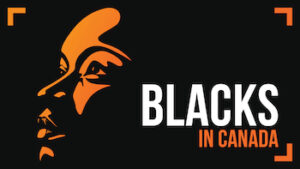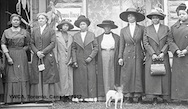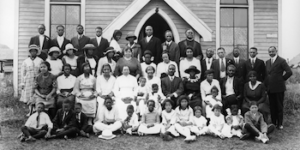
*A brief article on Black Canadian history before America’s Independence is recognized on this date.
The first recorded Black person to set foot on the land now known as Canada was a free man named Mathieu de Costa. He traveled with explorer Samuel de Champlain and arrived in Nova Scotia between 1603 and 1608. He translated for French explorer Pierre Dugua, Sieur de Monts. The first known Black person to live in Canada was a slave from Madagascar named Olivier Le Jeune, who may have been of partial Malay ancestry. As a group, Black people arrived in Canada in several waves.
Before the American Revolutionary War, Black people in Canada were slaves. Slavery had been legalized in 1705 in France and France's colonies. In Canada, some slaves were Aboriginal Canadians captured in wars, some were Black Africans, and some had been bought from the United States. After a war in 1763, England took control of New France. They had no laws allowing or forbidding slavery. At this time, 1200 blacks were living in Quebec. They were considered the property of their owners and had no legal rights. The first free Blacks in Canada came while serving in the French Army and Navy; some were enslaved. Later, some were indentured servants, as were some white immigrants.
During the American War of Independence, the British, who had a real need for soldiers, promised Blacks that they would be freed and could get some land by serving in the British army. Twenty thousand Blacks fought in the War of Independence. Although the British lost the war, they allowed five thousand Blacks to enter Canada and take the land they promised (mainly in the Maritimes). Because of this precedent, Canada began to stand out as a possible refuge from slavery.
The era of the American Revolution meant white Europeans in the United States had to decide where their future lay. Those loyal to the British Crown were United Empire Loyalists who came north. White American Loyalists brought their African slaves with them. At the same time, formerly enslaved Blacks, about 10% of the total, also made their way to the colonies of British North America, settling predominantly in Nova Scotia. This latter group set up a home in Birchtown near Shelburne. Some settled in New Brunswick, where racism was prevalent; whites held slaves and enforced racial rules.
In 1782, one of the first race riots in North America took place in Shelburne, with white soldiers attacking Black settlers who were getting work that the soldiers thought they should have. Unfortunately, the charter of the city of Saint John was amended in 1785 expressly to exclude blacks from practicing a trade, selling goods, fishing in the harbor, or becoming freemen; these provisions stood until 1870.

Ontario YWCA 1912
Due to the British government's promises that were not kept and white colonists' discrimination, 1,192 African men, women, and children left Nova Scotia for West Africa on January 15, 1792. They settled in what is now Sierra Leone, where they became the original settlers of Freetown. Along with other groups of free transplanted people, such as the Black Poor from England, the Sierra Leone Creole people, also known as the Krio, became the Sierra Leone people.
In 1793, John Simcoe, Governor of Upper Canada, passed a law entitled An Act to Prevent the Further Introduction of Slaves and to Limit the Term of Enforced Servitude Within this Province. It did not completely abolish slavery because some of the legislators owned slaves. In 1796, a group of fiercely independent rebels known as the Trelawney Maroons was moved from Jamaica to Nova Scotia following their long battle against colonization. While there, these Jamaican Maroons deterred an attack by Napoleon and constructed parts of the Halifax Citadel and all of Government House. After only a few winters, the British government decided sending them to Sierra Leone would be cheaper than trying to persuade them to farm in a cold country. Upon their arrival in West Africa in 1800, they were used to quell an uprising among the previous settlers mentioned above, who were unhappy with their treatment by the Sierra Leone Company after eight years.
While the Black liberation movement moved ahead in Upper Canada and Lower Canada, in 1813, nearly 2000 escaped slaves settled in Nova Scotia. There was a recession at the time, and the white citizens complained that the Blacks were taking too many jobs. The next significant migration of blacks occurred between 1813 and 1815. Refugees from the War of 1812 fled the United States to settle in Hammonds Plains, Beechville, Lucasville, North Preston, East Preston, and Africville. A Black Loyalist named Richard Pierpoint, born about 1744 in Senegal and settled near present-day St. Catharines, Ontario, offered to organize a Corps of Men of Color; this was refused, but a white officer raised a small Black corps. This "Colored Corps" fought at Queenston Heights and the siege of Fort George, defending what would become Canada from the invading American army. In 1815, Nova Scotia banned further immigration by Blacks.
The immigration of Black American slaves to Canada began to focus on Ontario. In 1842, two American abolitionists, Hiram Wilson (a white minister) and former fugitive slave Josiah Henson, established the Dawn Settlement. Dawn was a center for education, training, community planning, and integration. With financial backing from American abolitionists, Dawn became a diverse settlement featuring a school, brickyard, sawmill, farmland, and profitable lumber industry.
The settlers engaged in active trade and significantly increased the value of the land they worked on and populated. Just before the American Civil War (1858), James Douglas, the governor of the British colony of Vancouver Island, whose mother was Creole, replied favorably to an inquiry from a group of Blacks in San Francisco about the possibilities of settling in his jurisdiction. At the Cariboo Gold Rush outbreak, several dozen Black migrants traveled to Victoria. Two of them, Peter Lester and Mifflin Gibbs, became successful merchants there, and Gibbs was elected to the City Council in the 1860s.
Many black Canadians in Nova Scotia and Southern Ontario trace their ancestry to African America. Their ancestors were slaves who used the Underground Railroad to flee the United States, seeking refuge and freedom in Canada. From the late 1820s until the American Civil War began in 1861, tens of thousands of fugitive slaves came to Canada. While many of these returned to the United States after emancipation, a significant population remained in Southern Ontario, widely scattered in rural and urban locations, including Toronto. Mariner William Hall was the first Black, the first from Nova Scotia, and the third Canadian-born recipient of Canada's Victoria Cross.
Following American Reconstruction, there was an unofficial policy restricting Blacks from immigration. Before World War I, the massive influx of immigrants from Europe and the United States included only a few blacks. This was formalized in 1911 by Prime Minister Sir Wilfrid Laurier: "His excellency in Council, in virtue of the provisions of Sub-section (c) of Section 38 of the Immigration Act, is pleased to Order and it is hereby Ordered as follows: For a period of one year from and after the date hereof the landing in Canada shall be, and the same is prohibited of any immigrants belonging to the Negro race, which race is deemed unsuitable to the climate and requirements of Canada."
The flow of Blacks seeking a better life between the United States and Canada continued in the twentieth century. A wave of immigration occurred in the 1920s, with Blacks from the Caribbean coming to work in the steel mills of Cape Breton, replacing those who had come from Alabama in 1899. Some Black Canadians trace their ancestry to people who fled racism in Oklahoma, Texas, and other American Great Plains states in the early 1900s to move north to Alberta and Saskatchewan; examples are graves in the Shiloh Baptist Church cemetery in Saskatchewan.

Emanuel African Methodist Church, Edmonton 1920
Many encountered racism after arriving in Canada, which they had regarded as the Promised Land. Many of Canada's Railway Porters came from the American South, New York City, and Washington, D.C., mainly settling in Montreal, Toronto, Winnipeg, and Vancouver. A noted cause célèbre in the 1920s was the case of Matthew Bullock, who fled to Canada to avoid a potential lynching in North Carolina and fought extradition. Black Canadians have contributed to many areas of Canadian culture. Many of the first visible nonwhites to hold high public offices and more have been Black, including Michaëlle Jean, Donald Oliver, Ferguson Jenkins, Rosemary Brown, Portia White, and Lincoln Alexander. Black Canadians form the third-largest visible nonwhite group in Canada, after South Asian and Chinese Canadians.
Population
According to the 2021 census by Statistics Canada, 1,547,870 Canadians identified as Black, constituting 4.3% of the entire Canadian population. Of the black population, 10 percent identified as mixed-race or "white and Black." The five most Black-populated provinces in 2021 were Ontario, Quebec, Alberta, British Columbia, and Manitoba. The ten most Black-populated census metropolitan areas were Toronto, Montreal, Ottawa, Edmonton, Calgary, Winnipeg, Vancouver, Hamilton, Oshawa, and Québec City. Preston, in the Halifax area, is the community with the highest percentage of Black people, with 69.4%; it was a settlement where the Crown provided land to Black Loyalists after the American Revolution. Brooks, a town in southeastern Alberta, is the census subdivision with the highest % of Black people, with 22.3%. The community there is mainly composed of East African immigrants.
The ten largest sources of migration for Black Canadians are Jamaica (136,505), Haiti (110,920), Nigeria (109,240), Ethiopia (43,205), the Democratic Republic of the Congo (37,875), Cameroon (33,200), Somalia (32,285), Eritrea (31,500), Ghana (28,420), and the United States (27,055).
69.1% of Black Canadians are Christian, while 11.9% are Muslim and 18.2% are irreligious. This is compared to 53.3%, 4.9%, and 34.6%, respectively, of Canadians. Among first-generation Black Canadian immigrants, 74.2% are Christian, 13.3% are Muslim, and 11.4% are irreligious.
A small number of Black Canadians (0.6%) also have some Indigenous heritage due to historical intermarriage between Black and First Nations or Métis communities. Historically little known, this aspect of Black Canadian cultural history began to emerge in the 2010s, most notably through the musical and documentary film project The Afro-Métis Nation.
Ontario Black History Society
10 Adelaide St. E. Suite 402
Toronto, ON, Canada M5C 1J3
416.867.9420